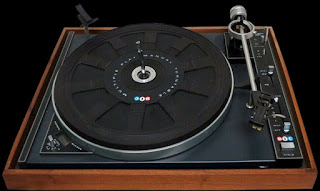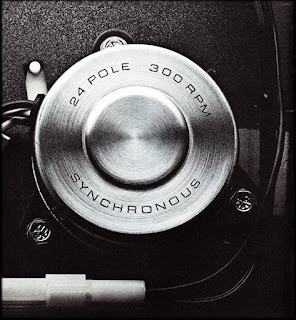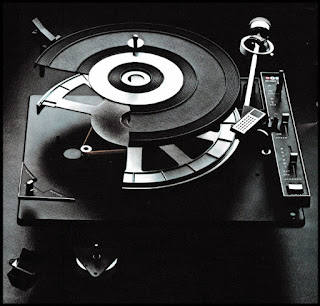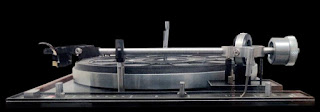The BIC 980
represent a considerable design achievement. For possibly the first time,
engineers have embarked on a turntable design project unhampered by
preconceived notions or existing peces of hardware. As a result, each of the
turntable's three operation systems i tone arm, programmer and drive are new.
The Motor
The 24-pole, 300 rpm
motor which power BIC turntables differs from motors used in automatic
turntables. Its low rpm and smooth flow of power tends to eliminate the
instability and vibration which create playback distortion in automatic
turntables.
The BIC turntable
motorat spdeed of 300 rpm it does not generate the heat/friction of high
revving motors and its vibration frequencies fall below the audible range. With
this low speed motor, a larger pulley can be used, minimizing tolerance and
speed variation problems presented by smaller pulleys in conventional machines.
The BIC motor is a synchronous unit which lock into the AC line frequency (or
to its own electronically generated reference signal in the case of the 980).
The coil are completely shielded, in order to keep dust and dirt may cause
noise in other parts of the system
The Drive System
This mechanism
reduces the speed of the motor shaft and transfers its turning force to the
platter. Automatic turntables accomplish this through an intermediate idler
wheel. BIC turntables use a belt-drive system which, until now, has been found
only in fine manual and single play turntables.
Solid State
Electronics
In the 980,speed
accuracy is maintained and variable pitch adjustment is controlled by solid
state circuitry. In conventional units, pitch control is accomplished through
far less stable mechanical linkages.
The BIC turntable
motor is a sophisticated, 24-pole synchronous unit which locks in to power line
frequency, rather than line voltage. While line frequency is much more stable
than voltage, it is still subject to variation in extreme cases. Therefore, the
BIC 980 features a solid state electronic circuit which performs two
stabilizing functions. It incorporates a Wien Bridge oscillator which generates
an electronic signal that is more accurate and consistent than AC line
frequency. It contains a variable speed control which allows the user to change
the pitch electronically, with perfect accuracy. Electronic circuitry is the
most reliable technology for assuring perfect speed stabilization. In the BIC
980 the solid state circuit board does away with mechanical pitch control
linkages found in the majority of automatic turntables which invariably
deteriorate with age.
Pitch Control
Pitch can be varied
±3% on the BIC 980. because the change is accomplished electronically, the
control knob can be moved effortlessly. This eliminates the danger of jarring
the machine while changing pitch and damaging the record or stylus.
Illuminated
Stroboscope
The lighted strobe
scale is fixed to the underside of the turntable and can be read easily through
a window next to the control knob while a record is being played. Until now,
the electronic circuitry which controls speed and pitch has been a feature of only
the most sophisticated manual turntables. It has not ben available on any
automatic turntable with multiple play capability. It is the one important
feature distinguishing the BIC 980 from the 960. oterwise the two BIC
turntables are identical.
The Tone Arm System
The tone arm and all
controls are designed to provide exceptional performance rom the most
sophisticated cartridges. They eliminate tracking force variations in multiple
play - one of the major drawbacks of automatic units. They permit the user to
adjust the cueing rate - a feature currently found on no other turntable.
Anti-Skating and
Stylus Force Adjustment
Most of the leading
manual, and automatic players have two separate scales to adjust anti-skating -
one for conical and one for elliptical styli. Often these cales are difficult
to read. The anti-skate controls are generally clumsy and difficult to grasp.
The mechanism which makes the anti-skate compensation is normally a single
spring, with a separate scale and adjustment for tracking force; this scale may
or may not be positioned in direct relationship to the anti-skate control.
Ideally, both controls should be lockated side by side for convenient and
precise adjustment.
The tone arm is
mounted on needle bearings in a precision gimbal. Atop the gimbal ring, a
single calibrated scale "reads out" both anti-skate and stylus force
adjustments.flanking the scale are two easy-to-grip, clearly legible control
tabs. They are simple to manipulare, either one at a time or in tandem. The
control lever establishing the correct setting for conical or elliptical styli
is on the program panel.whenthis lever is moved to the position of the
corresponding stylus type,the calibrated scale on the gimbal ring shows precise
anti-skate setting.
Tracking Variation
When a series of
records is played on a changer, tracking force may vary as much as.6grams from
first record to last. To compensate, most changers are designed so that the
middle record tracks with the correct force. Single play performance becomes a
vicim of this averaging.
The pivotry of the
BIC tone arm has been engineered to eliminate this compromise. Variation in
tracking force from first to sixth record in multiple play is less than 0,1
gram.
The Cartridge Shell
This is a critical
link in a tone arm system. The ultimate performance of sensitive new stereo and
4-channel cartridge/stylus combinations depends on it. The BIC cartridge shell
can be fine-tuned for optimum tracking. No cartridge shell on any turntable has
its advantages.
The Program System
This is a major
innovation in turntable design. It gives the owner 7 possible manual and
single-play automatic options. No other turntable offers such flexibility in
the single play mode, yet simplifing the mechanism rather than making it more
complex.
Not too long ago a
single play turntable was the last word in playback performance. No changer or
turntable with automatic features could stand close comparison with a quality
manual unit. Today the situation has changed dramatically.
BIC programmed
Turntables present the most critical high-fidelity enthusiast with
systems-engineered instruments that meet (and in some cases exceed) the
standard set by fine manual turntables. At the same time, without any sacrifice
in performance, they include some very desirable automatic capabilities.
Specifications
Drive System
Motor: 300 rpm 24-pole synchronous , impedance
protected
Drive: Long-life,
precision ground, elastomer belt
Pitch
Adjustment: Electronically controlled
approx. ±3%
Pitch Control
Monitoring: built-in neon bulb lighted
strobe
Solid State
Electronic Motor Power Supply: stable
Wien Bridge oscillator driving quadrature related power amplifiers
Start-Up Time: full speed in less than 1/3 of a revolution
Turntable
Speeds: 33-1/3 and 45 rpm
Turntable
Plater: 12-inch, non-ferrous, one-piece
machined die cast, balanced turntable. Weight kinetically matched to motor and
drive system
Rumble (DIN): better than -65 dB
Wow and Flutter:
(WRMS): better than 0,05%
Tone Arm System
Construction: Tubular aluminum tone arm,in machined
gimbals, mounted on die cst platform by means of a machined brass shaft.
Pivot
Arrangement:
Vertical : Twin needle bearings pivoting in hardened
ball bearing races
Horizontal : precision ground brass shaft moving atp a
lateral ball bearing race.
Bearing
Friction: less than 5 mg (horizontal), 5
- 8 mg (vertical)
Pivot to Stylus
Length: 216,2 mm
Lateral tracking
Erroe (Max): 0,35°/in
Effective Tone Arm
mass: 18 RMS
Tone Arm
Resonance: less than 9 Hz
Tone Arm
Counterweight: one piece machined die
casting, with machined knurled band and elastomeric compliant
resonance/isolation damper
Stylus
Overhang: adjustable with supplied gauge
Initial 15° Vertical
Tracking Angle: user adjustable by means
of adjustment screw in cartridge shell to compensate for variation in cartridge
height (gauge supplied with unit)
Manual/Auto 15°
Compensator: 2-position lever in shell
Stylus Track Force
Range: 0 - 4 gms in 0,25 gm , calibrated
increments
Tracking Force
Accuracy: within 0,1 gm from 1st to 6th record
Anti-Skating Stylus
Mode Selector: lever selector for
conical or elliptical types
Anti-skating
Adjustment Range: 0 - 4 gms in 0,25 gm
, calibrated increments
Cueing System: Damped both directions
Cueing Rate: user adjustable approx. 1 - 3 seconds
Cartridge
Shell: male/female 4-pin gold-plated
connectors secured by locating pin and knurled locking nut
Finger Lift: Stainless stell professional type
Minimium Tripping
Force: less than 0,15 gms
Program System
Number of recirds
programmable: 1 to 6
Playing Modes: manual; Automatic; Single; Repeat Single up
to 6 times; Multiple Play up to 6 ecords
Cycle Button:
feather touch actuation of all automatic modes
Geberal
Record Size: 7 and 12 inches
Tone arm Wiring
Capacities: less than 20 pF/channel
Record Support: Reliable 2 point system, with safety support
platform for automatic record handling
Shock Mounts: 4 elastomeric mounts, computer designed for
the turntable
Power
Requirements: 105 - 130 VAC 60 Hz , 50
Hz adaptability
Shipping
Weight: 12 lbs





































